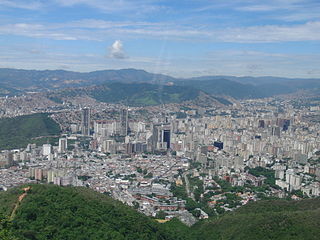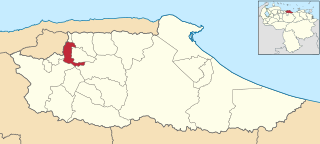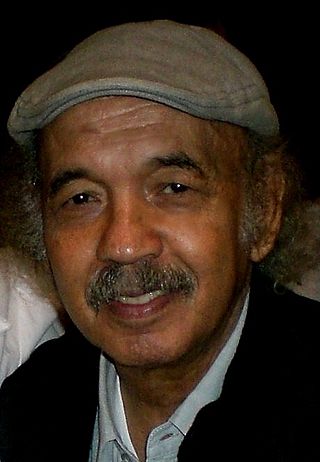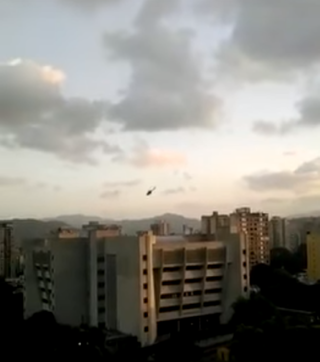
Caracas, officially Santiago de León de Caracas (CCS), is the capital and largest city of Venezuela, and the center of the Metropolitan Region of Caracas. Caracas is located along the Guaire River in the northern part of the country, within the Caracas Valley of the Venezuelan coastal mountain range. The valley is close to the Caribbean Sea, separated from the coast by a steep 2,200-meter-high (7,200 ft) mountain range, Cerro El Ávila; to the south there are more hills and mountains. The Metropolitan Region of Caracas has an estimated population of almost 5 million inhabitants.

Miranda State is one of the 23 states of Venezuela and the second most populous after Zulia State. As of the 2011 census, it had a population of 2,675,165 residents. It also has the greatest Human Development Index in Venezuela, according to the Venezuelan National Institute of Statistics. The most recent population estimate was 3,194,390 in mid-2016.

Baruta is a municipality within the Metropolitan District of Caracas in Venezuela.
Venezuelan literature is the literature written by Venezuelans or in Venezuela, ranging from indigenous pre-Hispanic myths to oral or written works in Spanish or other languages. The origins of Venezuelan written literature are usually held to date back to the documents written by the first Spanish colonizers, its date of birth being sometimes set at August 31, 1498, when Christopher Columbus called the Venezuelan territory in his Diaries "Tierra de gracia".

El Hatillo Municipality is an administrative division of the State of Miranda, Venezuela; along with Baruta, Chacao, Libertador and Sucre, it is one of the five municipalities of Caracas, the capital of Venezuela. It is located in the southeastern area of Caracas, and in the northwestern part of the State of Miranda.

Dulce Nombre de Jesús de Petare is a neighborhood in Miranda, Venezuela, and is part of the Metropolitan District of Caracas. It is located in the Sucre Municipality, one of the five divisions of Caracas. The city was founded in 1621 under the name of San Jose de Guanarito. It grew to become a part of the Greater Caracas area as the latter expanded in area and population. Petare had a population of 372,106 inhabitants and about 448,861 according to 2020 estimates. Petare is the biggest slum in Venezuela, and in South America.

Jacobo Borges is a contemporary, neo-figurative Venezuelan artist. His curiosity for exploring different mediums made him a painter, drawer, film director, stage designer and plastic artist. Known for his ever-evolving style, there is one constant principle that unites his work: "the search for the creation of space somewhere between dreams and reality where everything has happened, happens, and may happen." His theoretical approach and unique, innovative technique has won him acclaim all over the world. He has had solo exhibitions in France, Germany, Austria, Mexico, Colombia, Brazil, Britain and the United States. Today, he is considered one of the most accomplished artist of Latin America. His oeuvre includes a rich body of paintings, a film directed in 1969, and a book The Great Mountain and Its Era, published in 1979. In 1982, a biography by Dore Ashton, called Jacobo Borges, was published in English and Spanish.

Guillermo Tell Villegas Pulido, was a Venezuelan lawyer, writer, journalist, and politician who served as acting president of Venezuela. A lawyer early in his career, in 1876 he cofounded the school La Paz in Caracas. Also dedicated to journalism, he founded the publications Alianza Literaria in 1876, La Mayoría in 1879, and Monitor in 1889. Between 1879 and 1892 he held various political roles including Secretary of Interior of the Federal District, secretary general in the government of President Antonio Guzmán Blanco, and a trial judge in Caracas.
Luis Pérez-Oramas is a Venezuelan/American poet, art historian and curator. He is the author of eleven poetry books, seven recollections of essays, and numerous art exhibition catalogs. He has contributed as Op-Ed author to national newspapers in Venezuela as well as to various literary and art magazines in the U.S, Latin America and Europe.

East Caracas generally refers to the eastern portions of Caracas, and may refer specifically to the municipalities from the Metropolitan District of Caracas located in Miranda State: Chacao, Baruta, Sucre, and El Hatillo. It concentrates the 34.8% population of the Metropolitan District of Caracas, and the 21.7% population of the Greater Caracas Area. Caracas Country Club, the richest neighborhood of the city, is located between El Recreo and Chacao districts.
Graziano Gasparini was a Venezuelan architect, photographer, painter and historian, sometimes referred to as Graciano Gasparini.

The 2017 Venezuelan protests began in late January following the abandonment of Vatican-backed dialogue between the Bolivarian government and the opposition. The series of protests originally began in February 2014 when hundreds of thousands of Venezuelans protested due to high levels of criminal violence, inflation, and chronic scarcity of basic goods because of policies created by the Venezuelan government though the size of protests had decreased since 2014. Following the 2017 Venezuelan constitutional crisis, protests began to increase greatly throughout Venezuela.

The Mother of All Marches, also known as the Mother of All Protests, was a day of protests held on April 19, 2017, in Venezuela against the Chavista government of president Nicolás Maduro. The protests began after the Supreme Tribunal of Justice dissolved the National Assembly and took over its legislative powers March 29, 2017 in what was called a self-coup. The dissolution of the National Assembly was reversed shortly thereafter on April 1, 2017.

On 27 June 2017, there was an incident involving a police helicopter at the Supreme Tribunal of Justice (TSJ) and Interior Ministry in Caracas, Venezuela. Claiming to be a part of an anti-government coalition of military, police and civilians, the occupants of the helicopter allegedly launched several grenades and fired at the building, although no one was injured or killed. President Nicolás Maduro called the incident a "terrorist attack". The helicopter escaped and was found the next day in a rural area. On 15 January 2018, Óscar Pérez, the pilot and instigator of the incident, was killed during a military raid by the Venezuelan army that was met with accusations of extrajudicial killing.

The Sabana Grande district is divided into several middle class neighborhoods located in the Parroquia El Recreo of the Libertador Municipality, in the geographical center of the Metropolitan District of Caracas. It owes its name to the old town of Sabana Grande.
Armando Cañizales Carrillo was a Venezuelan violist member of the National Symphony Orchestra System killed during the 2017 Venezuelan protests.

Yolanda Pantin is a Venezuelan author who has mainly written poetry, although she has also worked in children's literature.

Caracas Ibero-American Film Festival is a Venezuelan film festival. It was initially created in 2003 with the purpose of promoting Ibero-American cinema, with emphasis on first movies. Subsequently, in 2021 it restarted its activities again.

The Guaire RiverMiners, also known as Guaire River Garimpeiros, is the name given to the people who search for metals in the Guaire River, a 72-kilometer-long river in Caracas, Venezuela that is highly contaminated with sewage. The miners are mainly minors, homeless people or blue-collar workers who lost their jobs due to the shutdown of government works or whose salaries are not enough to subsist and do not want to resort to crime. Despite being a practice that dates back to at least 1994, as of 2016 the number of people engaged in this trade increased to dozens and even hundreds during the Venezuelan economic crisis, characterized by hyperinflation and shortages.
















